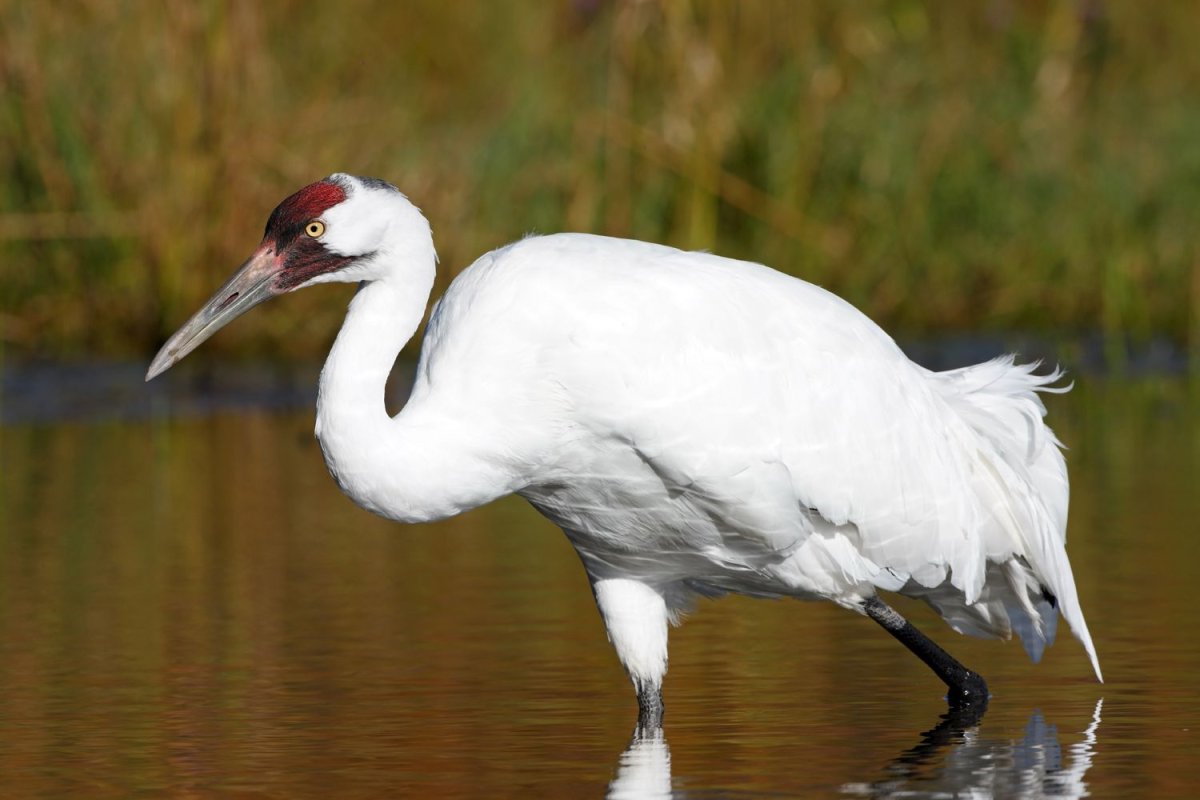
Whooping cranes are majestic white birds that stand 5 feet high, making them the tallest birds in North America. Due to hunting, their population dwindled to about 20 by the 1940s.
But after coming perilously close to extinction, they've been helped back by the tremendous dedication of scientists and advocates with groups like the International Crane Foundation, based in Baraboo, Wisconsin. This group has reintroduced hundreds of "whoopers" into the wild since 1973, and has helped establish a population that spends its summers in Wisconsin and flies to Florida in the winter. The largest group of cranes summers in Wood Buffalo National Park in northern Alberta in Canada, and in colder months flies south to the Aransas National Wildlife Refuge in Texas.
Threats they face include loss of habitat, collisions with power lines and predation by animals such as wolves, bobcats and eagles. But they are also increasingly ending up the victim of a violent human crime: gunfire.
Statistics from the International Crane Foundation show that nearly one in five whooping cranes in the eastern population whose cause of death could be determined had been shot. And in the past five years, more than 20 whooping cranes have been gunned down in the United States. That takes quite a toll since there are fewer than 500 of the animals remaining in the wild, says Lizzie Condon, with the foundation, who gave a presentation on the topic at the North American Congress for Conservation Biology in Madison, Wisconsin.
In early January, an 18-year-old Texas resident named Trey Joseph Frederick shot to death two whooping cranes near Beaumont, by the Louisiana border. These whoopers belong to a small non-migratory population that lives in Louisiana and which occasionally fly into Texas. With two shots, Frederick wiped out more than 4 percent of the reintroduced Louisiana flock, which consists of 44 animals.
Frederick admitted in court to shooting the birds, and to knowing that they were whooping cranes. He has pled guilty to violating the Endangered Species Act, specifically the possession of an endangered animal, which is Class A misdemeanor punishable by up to a year in prison and/or a $50,000 fine, says assistant U.S. Attorney Joseph Batte.

Sentencing for the case will take place in the next month or so, Batte says, and the International Crane Foundation is asking for the case to be "prosecuted vigorously" by judge Zack Hawthorn. In the past, shootings of cranes hasn't always been taken very seriously, Condon says. One Indiana case resulted in a $1 fine, for example. However, some cases have resulted in more severe penalties. In 2012, a man who shot a whooping crane in South Dakota was fined $85,000, sentenced to 30 days in jail, given two years of probation, had his hunting privileges revoked for two years and was also given community service. (However, in this case the penalty was worse because he was found guilty of threatening witnesses, Condon says.)
Elizabeth Smith, with the foundation, has asked the judge in a letter to sentence Frederick to no less than a month in jail, to levy at least a $15,000 fine and 300 hours of community service, and to revoke the teen's hunting license for at least five years.
An aggressive sentence "provides an opportunity to send this message: Shooting a Whooping Crane, similar to shooting a Bald Eagle, is not only a loss to the local community, it is a crime that has significant personal consequences," Smith writes in the letter. Condon notes that the foundation spends about $100,000 for every crane that is raised in captivity and released to the wild.

"Many have put our lives into this, and to see one shot...it's really upsetting," Condon says.
Among the problems is a lack of awareness of whooping cranes, how rare they are and how much has been done to grow their populations and keep them from going extinct. One pilot project by the group in Alabama, where the cranes have only recently begun to migrate through again after decades of being absent, found that only a small minority of people knew whoopers migrated through the area or knew basic details about the bird. And that is probably true of other areas where the cranes are found, Condon adds.
Condon and her group are trying to raise awareness about the birds, the story of their miraculous comeback from near-extinction and how they can lure tourism dollars to communities where they are found. The foundation has produced video and radio PSAs, put up billboards and reached out to schools and hunting groups in many areas where whoopers are found.
Luckily, most hunters are supportive of their efforts, as they want to follow the law and don't support the shooting of endangered species like whooping cranes, Condon says. In fact, hunters who live near Frederick are angry about the teen's actions, she adds, as such killings give a bad name to hunters.

Uncommon Knowledge
Newsweek is committed to challenging conventional wisdom and finding connections in the search for common ground.
Newsweek is committed to challenging conventional wisdom and finding connections in the search for common ground.
About the writer
Douglas Main is a journalist who lives in New York City and whose writing has appeared in the New York ... Read more
To read how Newsweek uses AI as a newsroom tool, Click here.






